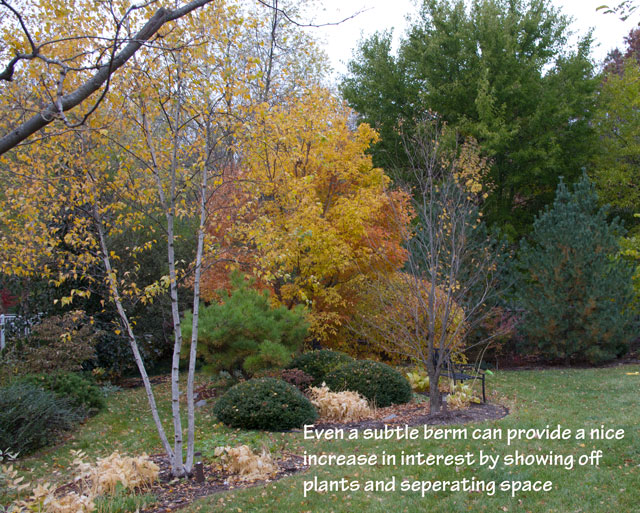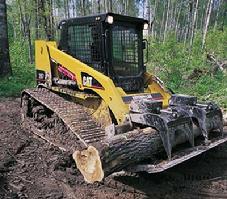One way to make a landscape look more interesting is to introduce topography changes. That’s a fancy way of saying, pile some dirt over here and there. The technical term used is the landscape trade is berms. Today, I will discuss how to add interest with berms.
Topography changes, add interest with berms
I would suggest that if you look at the most interesting landscapes that you see whether man made or natural, there will usually be topography changes. They may not be the 1st thing that jumps out at you, but they are usually there. Here are some examples.


Often, elevation changes are subtle or are hidden by plants or rock work. That does not mean that they are not there and are not having an impact on how the scene affects you.
Berms can serve purposes
Elevation changes are often an important part of subdividing spaces into separate areas for different uses. They can also be used to screen off views and sounds or make screens of plants more effective.

Topography and Your yard
OK, so what does this mean for your yard?
First, if you have a slope in your yard, stop cursing it as a pain in the neck to mow. I would instead urge you to think how the slope could be used or altered to make it an asset instead of a liability. There is untapped potential there.
Secondly, if you have a flat yard, start to think if you could add interest with berms to your yard to increase its variety or subdivide the spaces into different uses, such as a patio area and a children’s play area. Berms don’t have to be dramatic. In fact for mostly flat yards, subtle berms may seem the most natural.
Two things to remember about Berms
Berms usually dry out quicker than surrounding soil. This means you will have to water the plants in berms more often than if they were planted in the original soil. Drought tolerant plants, such as junipers, are often recommended to cope with the drier soil. Plants that require well drained soil can often be planted in berms and do very well.
The berm will settle over time. Depending upon how much organic matter is in the soil, your berm may settle a little or a lot. More organic matter, such as compost your added, the more it will settle.
What I did to add some interest to my flat yard
Here’s a before picture of my yard right before I added my berm.
Here are some shots of the process (lots of work moving dirt, Skid steers are nice if you have the money to hire them).
Here is how it looked with some of the plants added.
Here is how it looks right after it was done and then 8 years later.
If you are interested in ideas for making changes to your yard by adding berms but are lost for ideas, feel free to use my ask me a question page and include a photo and I will try to give you some ideas.
For more information than anyone could possibly want about berms, click this link.




Kiyoko says
Hi Jim-
thank you so much for including the 8 year old “after” picture. What a gorgeous result! It’s so well done! I have a small (really small!) 35×50 backyard in the Pacific Northwest. Last year, I created a raised bed in which to plant japanese maples, conifers and groundcover. Even after a year, the results are really nice. I do have to pay more attention to the ground plane, and make sure the grass doesn’t creep up into the berm (as it did this year.) I think keeping the edge neat is the hardest part of the project. An older, gorgeous japanese maple (Seiryu) that is about 15 years old, in another part of the yard, began succumbing to verticillium wilt. So the arborist will take out the tree, stump, and as many roots as they can. Result will be a big huge hole- perfect for a berm! I actually don’t have another choice…which sometimes makes things easier! Wish we had a steer skidder, but it wouldn’t fit through the gate anyway. Us oldtimers will have to slog soil in a wheelbarrow the old way. So, in will go some Styrax japonica and assorted ground covers. I also have some large boulders that were installed years ago, and they serendipitously work with how the new berm will go. Thanks again for the inspiration- the shape and height of your berm are exactly what I will emulate. Cheers, and thank you again for sharing!
Jim says
Thanks for your comment.
Holly Hardin says
Good morning! This article is helpful – thanks so much! I want to create a berm in a flat part of my yard. I just removed two trees (pine, apple) and I’m thinking that the tree roots will make it difficult for new plantings. Perhaps adding several inches of soil with a berm will help? That’s my theory, anyway. Any thoughts on that?
My husband is balking at the back breaking work of removing all the grass. Do you think I can just put some layers of newspaper over the grass, cover it with several inches of soil, and plant? How many inches of soil do you think would be needed, if you think this would work at all?
Jim says
I would remove the sod over cover it and kill it before building your berm. Let the grass decay over winter and then you should be able to build your berm on the now well decayed grass. If you just bury it dead it will take much longer to decay and will be a barrier to moisture and root movement through the soil layers.
Judy says
Hello Jim,
I’m planning a Japanese garden in my small yard, that includes berms and some low maintenance plants for my area (zone 9B- Florida). Any tips on how to p roceed with this design? I need all the help I can get! thanks, judy
Jim says
I would suggest you visit Morikami Museum and Japanese Garden in Delray Beach. http://morikami.org/
This could give you some ideas you could borrow and adapt to your site in a Florida climate.
pat says
Am installing a berm in my front yard. I want to add interest to my plain yard. I already have some dirt and nice topsoil to use. How to determine the shape and size of a berm that will improve my yard and make sense in front of a 24′ x 48′ mobile home. Do you have any suggestions or resources I could use. I also have some ornamental grasses to work with.
Jim says
I would look at this link: http://www.extension.umn.edu/garden/landscaping/implement/soil_berms.html
Chi Kapoor says
Thanks for the article Jim. I have the opposite issue where I’m trying to flatten my backyard that is sloped upward. The problem is that I have a house on my left, right, and back, so will need to either build a very expensive retaining wall, or was just suggested to look at a Berm. Furthermore, my landscaper told me that removing the soil is complex and expensive where I live, and the Berm would allow the soild to be reused. Have you ever seen a Berm used as a retaining wall, so a yard can be flattened?
I appreciate any thoughts you may have.
Chi
Jim says
Yes. Berms can be used to help to flatten yards. If the slope is not that severe, they can do the whole job. They are also often used with smaller retaining walls doing some of the work.
Depending upon how severe the slope is, you may want to create terraces that will allow you to have different level areas.
If it is sloped up as you go away from the house you have a wonderful potential for an aesthetic landscape with plants shown off in layers, perhaps a flowing stream down toward and in front of your patio area, etc. Of course, it may not be that USABLE. Terraces could add usable areas for you.
You do have to be a bit concerned about altering how water drains from and through your property. If your berm causes your neighbors house to flood, you may have a problem.
janice Pokorski says
Hello Jim, I just found your web site. You have great information and photo’s that really show seasonal color.
I rescued a Red Japanese Maple last spring. When I took it out of the pot I noticed it’s root ball was encased in a ball of clay. It’s very presence concerned me.
I would like to start a pruning program. I don’t know where to start and or what to think about. Your thoughts?
Thank you,
Janice
Jim says
Janice, thanks for the comments.
First branches to cut off are the dead ones. So you want to prune out winter die back, etc. For Japanese maples I would wait to early summer to start pruning anything more than deadwood.
When starting to prune a new tree, I usually start by removing defects, if it is a more mature tree. You can remove one type of defect, then another until you have pruned enough of the tree for that year. Then next year you do it again with different defects and any new ones that have grown.
Example defects include suckers, water sprouts, rubbing branches, branches that are growing back toward the center of the tree after growing out, branches growing downward, etc. You may want to look at my crab apple pruning posts(http://www.jimanderson.net/overgrown-crabapple-pruning-part1/)
If the tree is really young, it is more about picking the main trunk and branches and guiding the tree to grow in the shape I want.
I am planing on writing a few pruning posts in the next few months so, check back and hopefully I can help clarify this some more.
Jim
warren braun says
Yes, fine article and great pictures.
What are skid steers?
Jim says
Thanks Warren,
A skid steer is a machine that is used in the construction trades mainly for moving material and land grading.
V Edmonds says
Great article